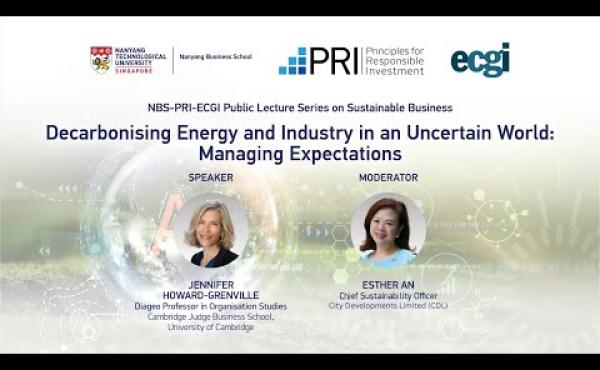
The ECGI blog is kindly supported by

Managing Expectations in the Race to Decarbonise
A review of the lecture “Decarbonising Energy and Industry in an Uncertain World” by Professor Jennifer Howard-Grenville 28th October 2025.
How can societies transform their energy and industrial systems fast enough to meet Net Zero goals when no one can say for sure which technologies will best deliver on these goals? This was the question at the heart of Professor Jennifer Howard-Grenville’s recent lecture at Nanyang Business School, part of the NBS-PRI-ECGI Public Lecture Series on Sustainable Business. Her talk explored how our expectations about technology development can drive both progress and paralysis in the race to Net Zero.
“An expectation is simply a statement about the future,” explained Howard-Grenville. Those statements can mobilise businesses, investors, policymakers, and the public —or mislead them. When expectations run ahead of technological reality, or lag too far behind, they distort decision-making and action. The challenge is to steer between hype, hesitation, and disbelief as we navigate toward a positive future.
The Costs of High, Low and No Expectations
To illustrate, Howard-Grenville invited the audience to imagine three investment options: a European EV battery gigafactory, a modern airship, or a renewable energy system for an unelectrified village. All were real projects.
The EV gigafactory—Sweden’s Northvolt—attracted investment of 15 billion Euro before filing for bankruptcy. Its trajectory illustrates hype: expectations outpacing the current reality. Hype mobilises effort, capital, and talent. But it also compresses timelines and narrows scope for adaptation when technology development doesn’t go as planned, as it often doesn’t. Under investor and customer pressure, Northvolt expanded too fast, drawing effort away from stabilising its manufacturing process as its core facility.
Hybrid Air Vehicles’ Airlander, a low-carbon airship with enormous potential for short-haul flight risks a different fate, of being trapped by low expectations. Caution and conservatism have kept it hovering at the margins, little known to many despite its successful piloting more than ten years ago. Howard-Grenville noted that the Airlander serves as a reminder that under-imagination can be as dangerous as overconfidence.
The third example—a Malian village powered by natural hydrogen discovered underground—showed the limits of imagination itself. This renewable energy source, produced continuously by geological reactions, had long been known to miners but rarely taken seriously by energy experts. It was a case of “no expectations”—and proof that absence of belief can constrain innovation as effectively as false certainty.
Together, these cases revealed a spectrum of misplaced expectations—too high, too low, or none at all—and how each can derail investment and progress on decarbonisation.
Harnessing the Power of Expectations
Expectations matter because they influence how societies allocate attention and resources. And they can cast long shadows: the early-2000s “hydrogen economy” imagined widespread adoption of hydrogen fuel-cell cars. Investment in such a future was so significant that President George W. Bush stated children born at that time may drive them as their first vehicle. When they failed to appear, scepticism hardened, reining in hope for other hydrogen applications to this day.
Yet expectations can also be productive. Moore’s Law, which began as Gordon Moore’s backward-looking observation that transistor density doubled every 18 months on computer chips, became a self-fulfilling prophecy that drove the trajectory of the entire semiconductor industry for decades. Similarly, even when speculative bubbles burst, they often leave behind valuable infrastructure. The dot-com boom of the 1990s built the digital backbone of today’s economy.
The emerging question is: “how do we best invest our time, innovation, and money without getting fooled by expectations?” The value of new technologies will always be uncertain. That is because incomplete knowledge, unanticipated discoveries, or unintended consequences are always associated with technology development. Recognising this is the first step to managing expectations wisely.
Howard-Grenville outlined four principles that can help us bring our expectations in line with reality when tackling technology development for decarbonising energy and industry:
- Look across the system. Map impacts and opportunities across the value chain, to take a hard look at where change is most needed and where technology can make the greatest difference. Be guided by real gaps and needs, which might not need a risky new technology so much as a clever configuration of the old and the new.
- Look ahead in time. Ask what must be true for an emerging technology to thrive under future conditions. Anticipate what else will shift to enable what might now seem nonsensical.
- Communicate credibly. Be sceptical about over-hyped innovations, overconfidence can erode trust and slow genuine progress.
- Stay alert to weak signals. Stay curious about what is unfolding beneath the surface—unexpected shifts can foreshadow opportunities for significant change.
Asia’s Adaptive Edge
In the discussion moderated by Esther An, Chief Sustainability Officer at City Developments Limited (CDL), attention turned to Asia’s unique position: rapidly urbanising, highly exposed to climate stress, yet rich in ingenuity.
“Mitigation won’t help us. We need adaptation and innovation.”
— Esther An
Innovation is not always about high-tech breakthroughs—it can mean reimagining traditional practices or rethinking everyday systems. Firms must experiment, measure, and share results to create collective learning loops. Above all, organisations must “have the humility to be wrong.”
Leadership requires bold curiosity: testing what works rather than waiting for perfection. With the clock ticking toward 2030 and most Sustainable Development Goals off track, businesses must harness practical incentives—energy security, efficiency, cost-savings—to drive change while staying mindful of social and environmental impact.
Howard-Grenville agreed with An’s observations. Real progress requires innovation, humility, and leadership. We have so much opportunity right now to address multiple challenges, including growth, security, and equity alongside decarbonisation. Let’s set our expectations and imaginations to the task.
-----------------------------------
This lecture is part of the NBS-PRI-ECGI Public Lecture Series, a global initiative on sustainable business. Nanyang Business School (NBS), in collaboration with the Principles for Responsible Investment (PRI) and the European Corporate Governance Institute (ECGI), launched this series to foster knowledge exchange between academics, practitioners, and policymakers. As part of this initiative, leading academics present cutting-edge research on sustainability topics, while industry experts moderate discussions, providing real-world insights and facilitating dialogue between research and practice.







